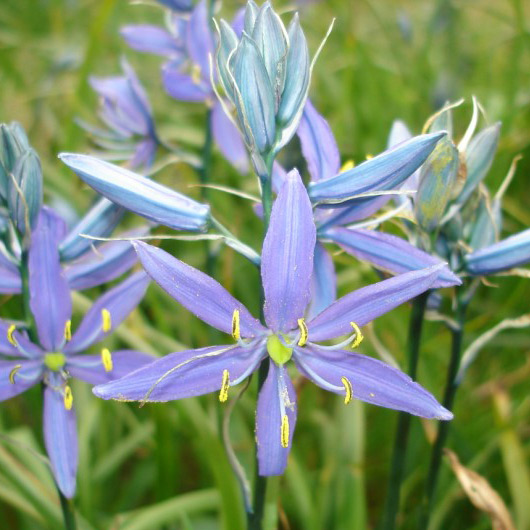Common Camas
Camassia quamash (Pursh) Greene

overview
Perennial herb from a deep, egg-shaped bulb 2-4 cm long; flowering stems 20-70 cm tall, smooth. Leaves: Basal leaves several to numerous, linear-lanceolate and grass-like, to 50 cm long, 1-3 cm wide, smooth, sheathing at the base, the margins entire; stem leaves lacking. Flowers: Inflorescence a terminal raceme of five to many, stalked flowers, the stalks 1-2 cm long, spreading in flower, ascending to erect in fruit; flowers pale to deep blue, rarely white, of six similar, distinct, petal-like segments (tepals), the tepals 15-40 mm long, 2-8 mm wide; six stamens, anthers yellow to violet; one pistil, three-chambered. Fruits: Fruit capsules, egg-shaped to oblong, cross-ridged, 1-2.5 cm long; fruiting stalks shorter than the bracts, ascending to erect, curved in towards stem; seeds several to many, shiny black, 2-4 mm long (Douglas et al., 2001). Two varieties occur in BC: (1) Perianth segments three to five-veined, mostly less than 6 mm wide, usually less than 30 mm long; stalks appressed in fruit; plants from the dry interior: var. quamash, and (2) Perianth segments five to nine-veined, mostly more than 6 mm wide, usually more than 30 mm long; stalks ascending or spreading in fruit; plants from the coast: var. maxima (Gould) Boivin. Photo by Dave Polster.
other names
blue camas
family
Liliaceae
ecological setting
Mesic to vernally moist meadows and grasslands in the lowland, steppe and montane zones (Douglas et al., 2001).
soil texture
Nitrogen rich soils. Moder and Mull humus (Klinka et al., 1989).
soil reaction salinity
pH 5.1 to 7.8 (Dave’s Garden, 2006).
moisture regime
Dry to moderately moist soils (Klinka et al., 1989).
shade tolerance
Shade-intolerant (Klinka et al., 1989).
successional status
Seral species on moist sites. Fire climax on drier sites (USDA, 2006).
bec zone subzone status
Strongly associated with Coastal Douglas-fir (CDF) Zone and its dry sub-zone characterized by the presence of Quercus garryana (BCMOF, 1999).
site rehabilitation
Useful for prairie restoration (USDA, 2006).
wildlife
A good bee plant (PFF, 2006). Ungulates eat Camassia and gophers may even transport bulbs into new areas (Beckwith, 2004).
landscaping
Use in meadows, grassy slopes and banks. Showy bloom with attractive seed heads. Excellent in borders, mixed borders and bulb beds. Very tough plant for exposed, hot dry sites once established (S. Bastin, personal communication).
first nations
Staple root crop pre-European contact. Prolonged pit cooking converts the high levels of inulin inherent in Camassia to digestible sugars. Hence, Camassia was a sweetener as well as an important trade item. The gathering of Camassia illustrates local systems of land management: family plots were well tended throughout generations and kept clear of weeds and rocks, actively maintained by hand and controlled burns for long-term harvest (Turner, 1995). Cakes have been formed, cooked and dried for storage and trade (Pojar & MacKinnon, 1994).
flowering time
Early April through mid-May (Beckwith, 2004).
fruit ripening time
May through summer (Beckwith, 2004).
seed collection time
July through summer (Beckwith, 2004).
crop intervals
Annual after first 2-3 years (USDA, 2006).
no seeds per kg
258,015 (Plants Database, 2006).
seed viability
Good (PFF, 2006; Pettinger, 2002; Beckwith, 2004).
collection and abstraction
Allow seedheads to dry on plant, then remove and collect (Dave’s Garden, 2006). Common camas seeds can be collected as soon as the pods mature (turn light brown) or split open to reveal the mature black seeds. Pods ripen from late May-July depending on latitude, longitude, moisture conditions, or elevation (USDA).
seed storage
Dry seeds can be dried and stored at 3-5º C for 2 to 5 years (USDA, 2006).
fruit seed dormancy treatment
For maximum germination, seeds should have 42 -100 days of cold, moist stratification at 1-5º C (Beckwith, 2004). Alternatively seed can be sown in trays or pots in the fall and allowed to break dormancy naturally (Wick and Evans). After fall sowing, one-leafed, grass-like seedlings will emerge in February or March under suitable conditions. Seedlings require moisture through the spring growing period to survive. Warm temperatures during seedling development can be lethal (USDA). Seeds can also be sprinkled on top of soil in flats lined with pea gravel. The flats should be a minimum of 15 cm deep and should then be kept in a semi-shaded location for many years. This will form a sod or turf which can be cut up and placed in gardens, meadow planting or landscaping (Pettinger and Costanzo, 1981).
vegetative propagation
| Method | Success Rate | Time of Collection |
|---|---|---|
| Softwood cuttings | ||
| Semi-hardwood cuttings | ||
| Hardwood cuttings | ||
| Root cuttings | ||
| Suckers | ||
| Plant division | Good (USDA Plant Data Sheet). Bulbs, bulblets and offsets can be successfully transplanted (Beckwith, 2004). | Early summer to mid-fall after leaves die back. |
additional info and photos
For more information and pictures, visit the E-Flora BC website at www.eflora.bc.ca.